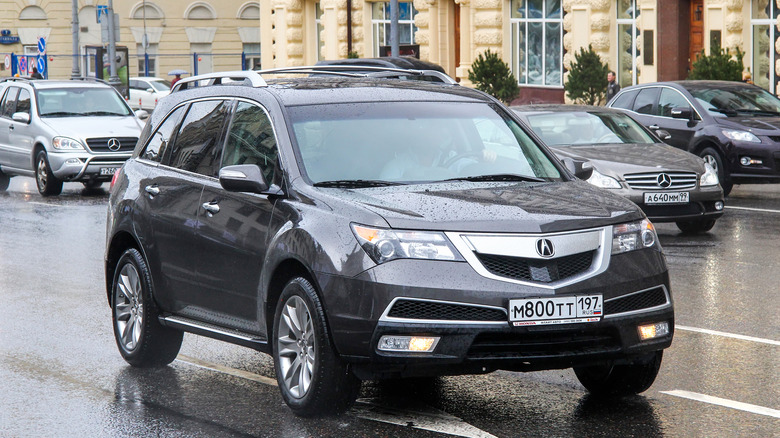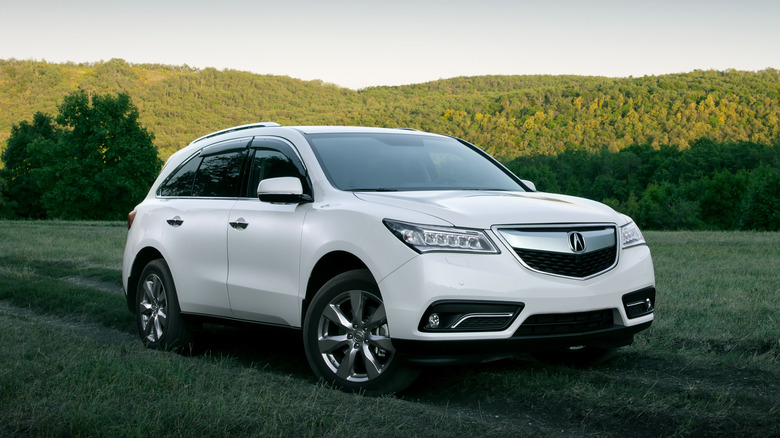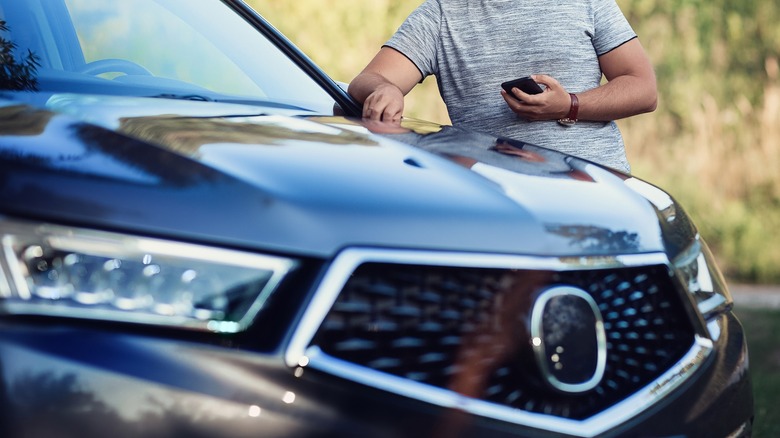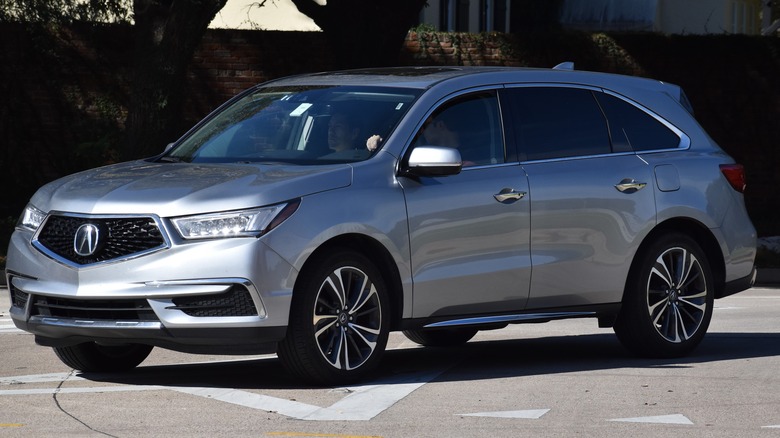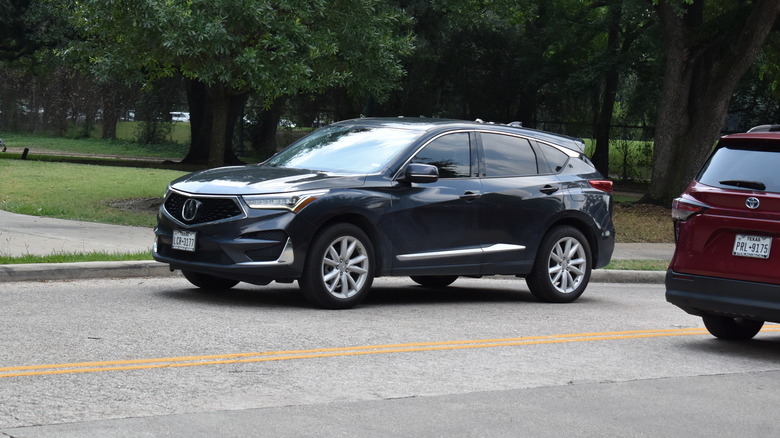5 Acura Safety Features That Could Save Your Life
It's easy to take driving for granted. It's a way to get from A to B, a bit of a hobby, a passion, a school run, and a commuting necessity. It's become such an entrenched part of so many people's everyday lives (there are approximately 1.4 billion vehicles on the planet as of 2024, according to Hedges & Company) that we sometimes don't give the safety concerns inherent in driving a second thought.
The importance of the drawing of the seatbelt, now all but muscle memory, is self-explanatory, and modern vehicles bristle with other safety features we're all familiar with, too. From child locks on the doors to airbags and proximity sensors, our vehicles and their manufacturers must emphasize driver safety at every turn. Honda's luxury division, Acura, boasts a suite of original features that drivers may not be familiar with but could prove to be of vital importance should the very worst happen.
These five notable safety systems in Acura vehicles may very well save the lives not only of drivers but also of passengers, pedestrians, and those in other vehicles. Advanced safety systems in vehicles may be costly, but they can be very important, too.
Adaptive Cruise Control
Speed limits, first and foremost, are a safety measure. Generally, the faster a vehicle travels, the more difficult it is to control, so tragic accidents can befall those who see fit to disregard these limits. Consistent driving, you might say, is safe driving, and this is what the concept of cruise control is all about: reaching a certain speed, activating the system, and allowing your vehicle to maintain that speed automatically.
In today's cars, cruise control is often an as-standard sort of feature rather than a convenient novelty or a luxury. While the technology will differ from manufacturer to manufacturer and model to model, Acura has developed its own Adaptive Cruise Control.
The system is adaptive as it doesn't just concern the speed of your vehicle. It can also monitor how close cars ahead are and keep a predetermined distance away from them. This system can be activated at up to 95 mph, and the driver can determine the space they wish to be left between themselves and the vehicle ahead by inputting their desired following interval (by pressing the Interval button a corresponding number of times). The Multi-Information display will show the distance selected, though the exact distance this corresponds to will be different depending on the Acura model you're driving.
All Acuras have Adaptive Cruise Control by default, which can be invaluable for keeping road users safe.
Jewel Eye LED Lighting
Naturally, when driving at night, headlights are crucial. Overly-extreme ones, however, can be a real discourtesy at best and a tragedy waiting to happen at worst. Acura's approach to ensuring you can see as well as possible when driving in the dark without compromising anybody else's vision is the Jewel Eye LED Lighting system.
This technology, also a standard issue on all new Acuras, consists of two quintets of LED lights. They have multiple purposes, Acura underlines: As daytime running lights when the illumination isn't needed, as powerful, bright, and energy-efficient headlights when a high beam is needed, and as more of a precise yet unobtrusive light (from other drivers' perspectives) when low beams would suffice. The central lights in the arrangement are utilized at high beams, while the positioning and angle of the five lights are designed for wider coverage of the road and its surroundings. The concept, then, is a lighting system that is adaptable to the driver's needs and current conditions.
It's true that LED headlights aren't definitively safer than others. In February 2019, the Cleveland Eye Clinic's Dr. Tom Chester told ABC Action News, "Patients often come in talking about difficulty driving at night with glare, headlight," expressing concern about the rise in these brighter lights. However, when used appropriately and conscientiously by drivers, Acura's Jewel Eyes have the potential to serve as a very powerful safety tool.
ACE Body Structure
Sadly, no amount of driving skill and experience or vehicle safety features can outright prevent accidents. To that end, another potentially life-saving element built into the fabric of an Acura is the ACE Body Structure.
Advanced Compatibility Engineering is an exclusive technology also used in the development of Honda models. It isn't intended to prevent accidents but to enhance safety in another crucial way: By making any potential crash less devastating for the integrity of the vehicle, thereby helping to protect those inside. Just as tank armor is intended to mitigate and deflect the force of a strike, so ACE Body Structure was designed to absorb some of the force of a crash on the front of a vehicle.
ACE, available in all Acura models except the NSX (a sports car Acura once chopped in half in the name of research), was developed using information gathered by the company's Real Impact technology, which gives engineers in-depth looks at an array of accident simulations and their predicted effects. The result is a complex vehicle "skeleton," in which reinforced sections in the corners and throughout (dubbed braces by Acura) help to spread some of the force of the impact with another vehicle across the front of the Acrua's/Honda's body. In this way, there is less chance of any one area of the vehicle's body buckling, and so endangering the vehicle's occupants.
Acura Blind Spot Information System
Blind spots, too, are a constant concern for conscientious drivers. After all, it's one thing to remain alert and attentive to everything you can see, but predicting what you can't is a different matter entirely. Those signs on larger vehicles that warn fellow drivers that, if they can't see that vehicle's mirrors, that vehicle can't see them? There's something unnerving about that. The Acura Blind Spot Information System included with the AcuraWatch and A-Spec bundles with applicable models, is intended to reduce this danger.
In a YouTube introduction to the system from September 2019 (as seen above), Acura explains the concept behind the feature. It "becomes active at speeds above 20 mph to assist during lane changes" and tracks the positions of vehicles in adjacent lanes. Should the Acura driver's turn signal then correspond with those positions, the Blind Spot Information System will inform them of this through a warning chime, light, or indicator on the Multi-Information Display.
This supplementary feature can prove invaluable. The October 2021 study "Assessment of Significant Factors Affecting Frequent Lane-Changing Related to Road Safety: An Integrated Approach of the AHP–BWM Model," from Danish Farooq et al., states that "official statistics estimated that at least 33% of all road crashes happen as vehicles alter lanes or turn off the road." A feature focused on this particular aspect of a journey, then, can be crucial.
Lane Keeping Assist
Long road trips can be an absolute blast if you've planned some good company, snacks, and music for the journey. However, they can also be hard work, with long, unchanging lanes potential being the bane of many.
Where the Blind Spot Information System can be very helpful in changing lanes safely, another Acura safety feature, Lane Keeping Assist, may be just as potentially important in ensuring you literally stay in your lane as long as necessary. It works through a rear-view mirror camera, allowing the vehicle to identify the boundaries of the current lane and monitor the Acura's position relative to it as you drive.
The steering wheel on applicable models boasts a separate button with which to enable the feature, supporting your journey as needed in a way intended to be significant yet unintrusive. Intentionally leaving a lane's boundaries, with a turn signal indicating clear intent, will not activate any warning from the system. Acura reports that the system is to be used at speeds of above 45 mph. There are caveats to its use, as it's unavailable on roads without indicated lanes. Conditions must allow the camera to have a clear view in the first place (the steering 'correction' is also subtle and to be used only as guidance), but it's another tool that could potentially save more lives than your own.
